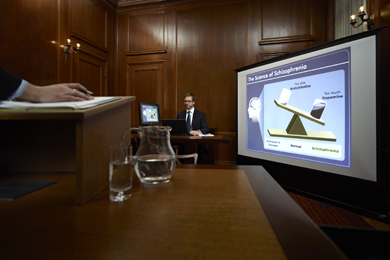Trial Presentation Your Partner for Powerful Evidence Demonstration in Court
Trial Presentation Your Partner for Powerful Evidence Demonstration in Court
Blog Article
Captivate the Jury: Necessary Elements of a Powerful Test Presentation
Important components such as recognizing the target market, crafting a compelling narrative, and mastering spoken and non-verbal interaction are vital components of an effective discussion. As these variables link, they create a cohesive strategy that not only notifies but also involves jurors on numerous levels.

Recognizing Your Audience
Understanding your target market is a pivotal aspect of effective trial discussion. A successful discussion rests on the capability to comprehend the demographics, worths, and tendencies of jurors. This understanding educates how arguments are framed, evidence is offered, and sob stories are crafted, ensuring that the message reverberates with the jurors on a personal level.
Research study indicates that jurors come from varied backgrounds and may have varying degrees of recognizing pertaining to lawful process. Furthermore, understanding the jurors' potential biases and life experiences permits the test speaker to prepare for objections and address issues proactively.
Reliable trial discussion additionally involves observing jurors' reactions throughout the procedures. Engaging with jurors as people instead than a cumulative system is essential in cultivating a strong connection in the court room.

Crafting a Compelling Story
Crafting an engaging narrative is vital in guiding jurors with the complexities of a case. A well-structured story not just simplifies elaborate lawful principles however additionally engages jurors on a psychological degree, making the details extra relatable and memorable.
To achieve this, lawyers should start by identifying the core message they want to communicate. This message must reverberate with the jurors' worths and experiences, fostering a connection that goes beyond plain truths. The narrative ought to unfold practically, offering events in a clear sequence to prevent confusion. This sequential approach can help jurors comply with the progression of occasions, emphasizing domino effect.
Integrating human components-- such as personal tales or anecdotes-- can even more enhance the story's influence. These components evoke empathy, allowing jurors to visualize the consequences of the situation on actual lives. In addition, utilizing a regular motif throughout the presentation strengthens the main disagreement, making it easier for jurors to maintain vital points.
Ultimately, a compelling narrative changes a trial presentation from a simple recounting of realities right into a convincing tale that captivates the court, urging them to ponder with both reason and feeling.
Using Visual Help
Incorporating visual help into a test discussion can considerably enhance jurors' understanding and retention of details. Aesthetic materials such as charts, layouts, photographs, and videos can change complicated lawful concepts and evidence right into conveniently absorbable layouts. By involving numerous senses, these help enable jurors to imagine the situation's crucial elements, making it simpler for them to follow along and realize complex details.
Moreover, properly designed aesthetic aids can highlight crucial points and highlight relationships in between different pieces of evidence. Timelines can efficiently illustrate the series of occasions, while annotated images can make clear certain information relevant to the case. This not just help in understanding but likewise enhances the narrative provided by the lawyer.
Excessively intricate or chaotic visuals might overwhelm jurors and detract from the message. Ultimately, efficient visual interaction can be an effective device in convincing jurors and assisting them reach informed conclusions.
Grasping Verbal Communication
Efficient spoken interaction is crucial in a trial presentation, as it serves as the primary methods through which browse around this web-site lawyers share their disagreements and connect with jurors. Understanding this skill involves quality, persuasion, and interaction. Attorneys have to articulate their points plainly and concisely, avoiding lawful jargon that might puzzle jurors. Simplicity in language fosters understanding and aids jurors understand complex issues offered during the trial.
In addition, tone and pacing dramatically effect just how messages are gotten. A positive tone shares authority, while proper pacing enables jurors to soak up information without really feeling bewildered. Attorneys must additionally vary their singing inflections to highlight vital factors and keep jurors' passion throughout the presentation.
In addition, the organization of verbal debates is important. Structuring the narrative logically and coherently helps jurors adhere to the lawyer's line of thinking, making it simpler for them to keep vital information. Making use of influential methods, such as narration, can additionally improve the emotional resonance of the arguments offered, consequently producing a more extensive connection with jurors.
Eventually, grasping spoken communication not only enhances a lawyer's case yet likewise fosters count on and relationship with the court, significantly improving the opportunities of a favorable decision.

Engaging With Body Movement
Nonverbal interaction plays a crucial role in test discussions, frequently sharing messages that words alone can not express. Body language, encompassing motions, pose, facial expressions, and eye get in touch with, dramatically affects how jurors view the credibility and genuineness of the presenter. A certain stance, with shoulders back and an open stance, can infuse trust, while closed-off body language might recommend defensiveness or unpredictability.

Face expressions must mirror the emotions associated with the case, enhancing the narrative existing. A genuine expression during a touching minute can elicit compassion and enhance the psychological allure. Ultimately, understanding body language is vital for effective trial presentations, as it improves verbal communication and establishes a compelling presence that resonates with the jury.
Conclusion
To conclude, captivating the jury requires a critical technique that includes comprehending the target market, crafting an engaging story, making use of visual help, grasping verbal communication, and engaging through body movement. Each aspect plays an important duty in creating an effective test discussion that reverberates with jurors on both psychological and intellectual degrees (trial presentation). By integrating these components properly, legal experts can dramatically improve their capacity to encourage and influence court decision-making
Report this page